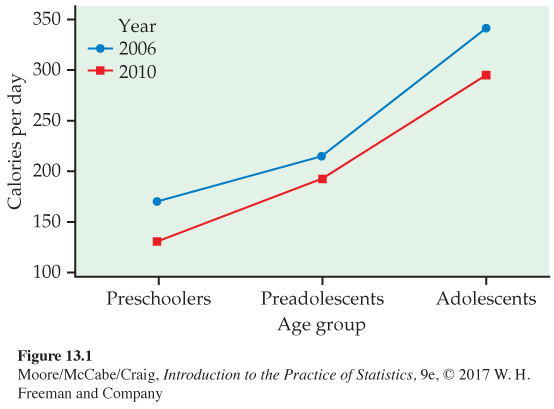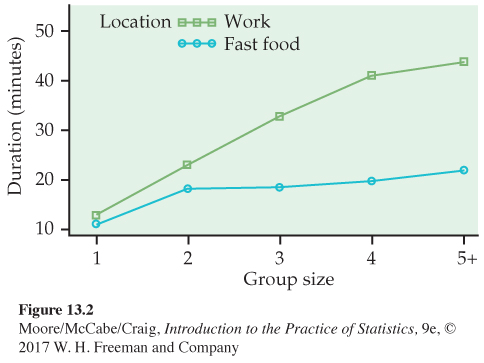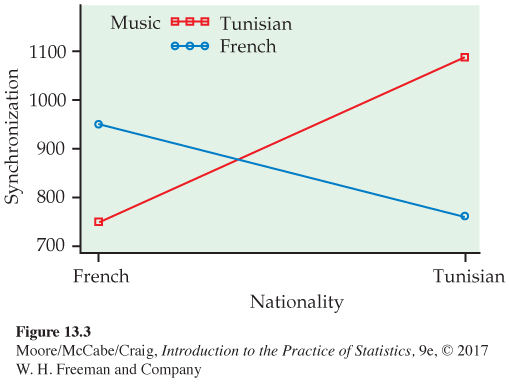13.1 13.1 The Two-Way ANOVA Model
When you complete this section, you will be able to:
• Discuss the advantages of a two-
way ANOVA design.• Describe the two-
way ANOVA model and when it is used for inference.• Interpret the relationship between two factors in terms of main effects and interaction.
• Construct an interaction plot and determine whether it shows that there is interaction among the factors.
We begin with a discussion of the advantages of the two-
Advantages of two-
In one-
factor, p. 644
EXAMPLE 13.1
Design 1: Does haptic feedback improve performance? In Example 12.1 (page 645), a group of technology students wanted to see if haptic feedback is helpful in navigating a simulated game environment. To do this, they plan to randomly assign 20 students to each of three joystick controller types and record the time it takes to complete a navigation mission.
It turns out that their simulated game has four difficulty levels. Suppose that a second experiment is planned to compare these levels when using the standard joystick. A similar experimental design will be used, with the four difficulty levels randomly assigned equally among the 60 students.
Here is a picture of the designs of the first and second experiments with the sample sizes:
| Joystick | n |
|---|---|
| 1 | 20 |
| 2 | 20 |
| 3 | 20 |
| Total | 60 |
| Difficulty | n |
|---|---|
| 1 | 15 |
| 2 | 15 |
| 3 | 15 |
| 4 | 15 |
| Total | 60 |
In the first experiment, 20 students were assigned to each level of the factor for a total of 60 students. In the second experiment, 15 students were assigned to each level of the factor for a total of 60 students. If each experiment takes one week, the total amount of time for the two experiments is two weeks.
Each experiment will be analyzed using one-
EXAMPLE 13.2
Design 2: Does haptic feedback improve performance regardless of difficulty level? Suppose that we use a two-
Here is a picture of the two-
| Difficulty | |||||
|---|---|---|---|---|---|
| Joystick | 1 | 2 | 3 | 4 | Total |
| 1 | 5 | 5 | 5 | 5 | 20 |
| 2 | 5 | 5 | 5 | 5 | 20 |
| 3 | 5 | 5 | 5 | 5 | 20 |
| Total | 15 | 15 | 15 | 15 | 60 |
Each combination of the factors in a two-
With the two-
EXAMPLE 13.3
The effect of a limited time offer on purchase intent. Starbucks’ Pumpkin Spice Latte (PSL) is the company’s most popular seasonal item. Why is this? Is it the unique flavor? Or could it be because it is only available for a limited time each year? To investigate this, some students surveyed 100 Starbucks consumers about their intent to purchase a PSL when it is offered in the fall.1 Half of the surveys included the upcoming PSL advertisement. The other half included the same advertisement with the additional words “Limited Time Offer’’ above the image of the drink. Because purchase intent may depend on how frequently a consumer visits Starbucks, the students included a survey question about this. The question was used to classify each customer as either a “light’’ or “heavy’’ user of Starbucks.
The factors for the two-
Here is a table of sample sizes that summarizes their design:
| User status | |||
|---|---|---|---|
| Advertisement | Light | Heavy | Total |
| Regular | 27 | 23 | 50 |
| Added wording | 19 | 31 | 50 |
| Total | 46 | 54 | 100 |
The students were not able to control the number of subjects in each cell of the study because they did not know user status until the survey was administered.
This example illustrates another advantage of two-
Consider an alternative one-
However, suppose that there are, in fact, differences due to user status. In this case, the one-
DATA = FIT + RESIDUAL, p. 560
EXAMPLE 13.4

Vitamin D and osteoporosis. Osteoporosis is a disease primarily of the elderly. People with osteoporosis have low bone mass and an increased risk of bone fractures. More than 10 million people in the United States, 1.4 million Canadians, and many millions throughout the world have this disease. Adequate calcium in the diet is necessary for strong bones, but vitamin D is also needed for the body to efficiently use calcium. High doses of calcium in the diet will not prevent osteoporosis unless there is adequate vitamin D. Exposure of the skin to the ultraviolet rays in sunlight enables our bodies to make vitamin D. However, elderly people often don’t go outside as much as younger people do, and in northern areas such as Canada, there is not sufficient ultraviolet light for the body to make vitamin D, particularly in the winter months.
Suppose that we wanted to see if calcium supplements will increase bone mass (or prevent a decrease in bone mass) in an elderly Canadian population. Because of the vitamin D complication, we will make this a factor in our design. We will use a 2 × 2 design for our osteoporosis study. The two factors are calcium and vitamin D. The levels of each factor will be zero (placebo) and an amount that is expected to be adequate, 800 milligrams per day (mg/d) for calcium and 300 international units per day (IU/d) for vitamin D.
Women between the ages of 70 and 80 will be recruited as subjects. Bone mineral density (BMD) will be measured at the beginning of the study, and supplements will be taken for one year. The change in BMD over the one-
Here is a table that summarizes the design with the sample sizes at the start of the study:
| Vitamin D | |||
|---|---|---|---|
| Calcium | Placebo | 300 IU/d | Total |
| Placebo | 25 | 25 | 50 |
| 800 mg/d | 25 | 25 | 50 |
| Total | 50 | 50 | 100 |
This example illustrates a third reason for using two-
These examples illustrate several reasons two-
ADVANTAGES OF TWO-
1. It is more efficient to study two factors simultaneously rather than separately.
2. We can reduce the residual variation in a model by including a second factor thought to influence the response.
3. We can investigate interactions between factors.
![]()
These considerations also apply to study designs with more than two factors. We will be content, however, to explore only the two-
The two-
When discussing two-
The numbers of levels of the factors are often used to describe the model. Again using our earlier examples, we would say that Example 13.2 represents a 3 × 4 ANOVA, and Example 13.4 illustrates a 2 × 2 ANOVA. In general, Factor A will have I levels, and Factor B will have J levels. Therefore, we call the general two-
In a two-
N=∑nij
ASSUMPTIONS FOR TWO-
We have independent simple random samples (SRSs) of size nij from each of I × J Normal populations. The population means μij may differ, but all populations have the same standard deviation σ. The μij and σ are unknown parameters.
Let xijk represent the kth observation from the population having Factor A at level i and Factor B at level j. The statistical model is
xijk=μij+ϵijk
for i = 1, . . . , I and j = 1, . . . , J and k=1,…,nij, where the deviations ϵijk are from an N(0, σ) distribution.
estimates of population parameters p. 653
Similar to the one-
ˉxij=1nijΣ
The k below the means that we sum the observations that belong to the (i, j)th sample.
The RESIDUAL part of the model contains the unknown σ. We first calculate the sample variances for each SRS. Provided it is reasonable to consider a common standard deviation (page 654), we pool these to estimate σ2:
Just as in one-
USE YOUR KNOWLEDGE
Question 13.1
13.1 Limited-
13.1 , i = 1, 2, j = 1, 2, k = 1, . . . , ; ~ N(0, ). We have I = 2, J = 2, n11 = 27, n12 = 23, n21 = 19, and n22 = 31. The parameters of the model are 11, 12, 21, 22, and .
Question 13.2
13.2 Limited-
| Light user | Heavy user | |||
|---|---|---|---|---|
| Advertisement | s | s | ||
| Regular | 4.56 | 1.75 | 5.00 | 1.79 |
| Added wording | 5.74 | 1.19 | 5.19 | 1.91 |
(a) Is it reasonable to pool the standard deviations for these data? Explain your answer.
(b) For each parameter in your model from Exercise 13.1, give the estimate.
Main effects and interactions
In this section, we will further explore the FIT part of the two-
So far, because we have independent samples from each of I × J groups, we have presented the problem as a one-
In two-
SSM = SSA + SSB + SSAB
and
DFM = DFA + DFB + DFAB
The term SSA represents variation among the means for the different levels of Factor A. Because there are I such means, DFA = I − 1 degrees of freedom. Similarly, SSB represents variation among the means for the different levels of Factor B, with DFB = J − 1.
Interactions are a bit more involved. We can see that SSAB, which is SSM − SSA − SSB, represents the variation in the model that is not accounted for by the main effects. By subtraction we see that its degrees of freedom are
There are many kinds of interactions. The easiest way to study them is through examples.
EXAMPLE 13.5

Investigating differences in sugar-
| Year | |||
|---|---|---|---|
| Group | 2006 | 2010 | Mean |
| Preschoolers | 170 | 130 | 150 |
| Preadolescents | 214 | 192 | 203 |
| Adolescents | 341 | 295 | 318 |
| Mean | 242 | 206 | 224 |
The table in Example 13.5 includes averages of the means in the rows and columns. For example, in 2006 the mean of calories consumed per day is
which is rounded to 242 in the table. Similarly, the corresponding value for 2010 is
which is rounded to 206 in the table. These averages are called marginal meansmarginal means (because of their location at the margins of such tabulations). The grand mean (224 in this case) can be obtained by averaging either set of marginal means.
Figure 13.1 is a plot of the group means. From the plot, we see that fewer calories from sugar-
To examine two-
![]()
When there is an interaction, the marginal means do not tell the whole story. For example, with these data, the marginal mean difference between years is 36 calories. This is smaller than the difference in calories for the preschoolers (170 − 130 = 40) and adolescents (341 − 295 = 46) and larger than the change in the preadolescents (214 − 192 = 22). If differences of roughly 20 calories per day are scientifically meaningful, then we would say that it appears there is an interaction. Inference is still needed to confirm that these differences are not likely the result of chance variation.

![]()
Interactions come in many shapes and forms. When we find an interaction, a careful examination of the means is needed to properly interpret the data. Simply stating that interactions are significant tells us very little. Plots of the group means, called interaction plotsinteraction plots, are essential. Here is another example.
EXAMPLE 13.6

Eating in groups. Some research has shown that people eat more when they eat in groups. One possible mechanism for this phenomenon is that they may spend more time eating when in a larger group. A study designed to examine this idea measured the length of time spent (in minutes) eating lunch in different settings.4 Here are some data from this study:
| Number of people eating | ||||||
|---|---|---|---|---|---|---|
| Lunch setting | 1 | 2 | 3 | 4 | 5 or more | Mean |
| Workplace | 12.6 | 23.0 | 33.0 | 41.1 | 44.0 | 30.7 |
| Fast- |
10.7 | 18.2 | 18.4 | 19.7 | 21.9 | 17.8 |
| Mean | 11.6 | 20.6 | 25.7 | 30.4 | 32.9 | 24.2 |
Figure 13.2 gives the plot of the means for this example. The patterns are not parallel, so it appears that we have an interaction. Meals take longer when there are more people present, but this phenomenon is much greater for the meals consumed at work. For fast-

A different kind of interaction is present in the next example. Here, we must be very cautious in our interpretation of the main effects because either one of them can lead to a distorted conclusion.
EXAMPLE 13.7
We got the beat? When we hear music that is familiar to us, we can quickly pick up the beat, and our mind synchronizes with the music. However, if the music is unfamiliar, it takes us longer to synchronize. In a study that investigated the theoretical framework for this phenomenon, French and Tunisian nationals listened to French and Tunisian music.5 Each subject was asked to tap in time with the music being played. A synchronization score, recorded in milliseconds, measured how well the subjects synchronized with the music. A higher score indicates better synchronization. Six songs of each music type were used. Here are the means:
| Music | |||
|---|---|---|---|
| Nationality | French | Tunisian | Mean |
| French | 950 | 750 | 850 |
| Tunisian | 760 | 1090 | 925 |
| Mean | 855 | 920 | 887 |
The means are plotted in Figure 13.3. In the study, the researchers were not interested in main effects. Their theory predicted the interaction that we see in the figure. Subjects synchronize better with music from their own culture. The main effects, on the other hand, suggest that Tunisians sychronize better than the French (regardless of music type) and that it is easier to synchronize to Tunisian music (regardless of nationality).

The interaction in Figure 13.3 is very different from those that we saw in Figure 13.1 and 13.2. These examples illustrate the point that it is necessary to plot the means and carefully describe the patterns when interpreting an interaction.
The design of the study in Example 13.7 allows us to examine two main effects and an interaction. However, this setting does not meet all the assumptions needed for statistical inference using the two-
![]()
In this study, we have a design that has each subject contributing data for two types of music, so these two scores will be dependent. The framework is similar to the matched pairs setting (page 182). The design is called a repeated-
USE YOUR KNOWLEDGE
Question 13.3
13.3 What’s wrong? In each of the following, identify what is wrong and then either explain why it is wrong or change the wording of the statement to make it true.
(a) A two-
way ANOVA is used when the outcome variable can take only two possible values. (b) In a 2 × 3 ANOVA, each level of Factor A appears with two levels of Factor B.
(c) The FIT part of the model in a two-
way ANOVA represents the variation that is sometimes called error or residual. (d) In an
13.3 (a) Two-way ANOVA is used when there are two factors (explanatory variables). (b) Each level of A should occur with all three levels of B. (Level A has two factors.) (c) The RESIDUAL part of the model represents the error. (d) DFAB = (I − 1)(J − 1).
Question 13.4
13.4 What’s wrong? In each of the following, identify what is wrong and then either explain why it is wrong or change the wording of the statement to make it true.
(a) Parallel profiles of cell means imply that a strong interaction is present.
(b) You can perform a two-
way ANOVA only when the sample sizes are the same in all cells. (c) The estimate is obtained by pooling the marginal sample variances.
(d) When interaction is present, the marginal means are always uninformative.